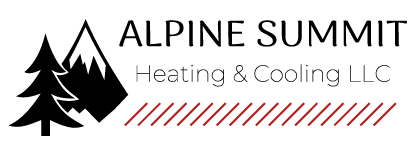
Ceiling fans are one of the most underrated ways to increase home comfort and cut energy costs. By boosting air circulation and working in conjunction with your HVAC system, ceiling fans and energy efficiency are truly a natural pairing. They offer a smart, eco-friendly way to keep cool while reducing strain on your AC—even preventing unnecessary air conditioning repair.
In this blog, the experts at Alpine Summit Heating & Cooling explain how ceiling fans can keep you cool while avoiding energy waste with increased HVAC efficiency. We'll also provide some HVAC efficiency tips that put to good use ceiling fans.
Comfort vs. Temperature: The Effect of the Wind-Chill Effect Indoors
Ceiling fans don’t actually change the room’s temperature—they make your home more comfortable by increasing air movement across your skin. This is known as the wind-chill effect, and it can make a room feel up to 4 degrees cooler without lowering the thermostat. That means you feel less hot and enjoy the benefits of indoor air circulation from your ceiling fan while minimizing air conditioner use—helping reduce your electric bill in summer.
The Best of Both: Why You Should Use Fans and Air Conditioning Together
There are several advantages to using ceiling fans and air conditioning at the same time, especially when it's very hot outside. By combining both, you increase HVAC efficiency and enjoy a cooler living space with less effort from your cooling system.
Why you should use ceiling fans and AC together:
- Ceiling fans help lower HVAC load by spreading cool air more evenly throughout the room. Reducing HVAC stress is important, because it can help you avoid a breakdown that could result in premature AC or furnace installation.
- Using overhead fans enhances comfort by getting rid of warm pockets and increasing airflow.
- Combining ceiling fans and AC can cut energy consumption. If you have a home automation system, you can even adjust your smart thermostat settings to bump up the temp a few degrees while your ceiling fan is running.
Clockwise vs. Counterclockwise Ceiling Fan Rotation: Which is the Correct Direction?
To maximize the benefits of your ceiling fans year-round, it’s important to ensure blades are rotating in the right direction for the season. The direction affects how air circulates, which can either make you feel cooler or redistribute heat so you feel warmer.
When to spin ceiling fans counterclockwise
In the summer, ceiling fans should rotate counterclockwise at a higher speed. This creates a breeze that forces cool air down, increasing the wind-chill effect and creating a cooler sensation.
When to spin ceiling fans clockwise
In the winter, set your fan to spin clockwise on a gentle setting. This gently pulls cool air upward and pushes warm air near the ceiling down toward you, making the space feel cozier without adjusting your thermostat.
What Type of Ceiling Fan Is Best
Selecting the ideal ceiling fan depends on a few key factors, including blade design, airflow rating and room dimensions. First, look for fans that offer a good balance of ECFM airflow and blade pitch to provide efficient air circulation in your space:
- ECFM is the amount of air a fan circulates—the cubic feet per minute, or CFM—per watt of electricity used. Fans with higher ECFM are the most energy efficient.
- Blade pitch refers to the tilt of the blades. A steeper blade pitch moves more air than a shallower pitch but can also strain the motor.
Also, consider room size when sizing a ceiling fan—a fan that’s too small won’t move enough air, while one that’s too big may be too strong for the space.
Boost Your HVAC Efficiency With the Team from Alpine Summit Heating & Cooling
At Alpine Summit Heating & Cooling, our HVAC specialists can help you stay comfortable while reducing strain on your heating and cooling systems. From energy-saving ceiling fan tips and air conditioning installation to smart thermostats and furnace repair, we offer comprehensive services that work with your budget. Schedule your appointment by calling 208-561-1226 today.




